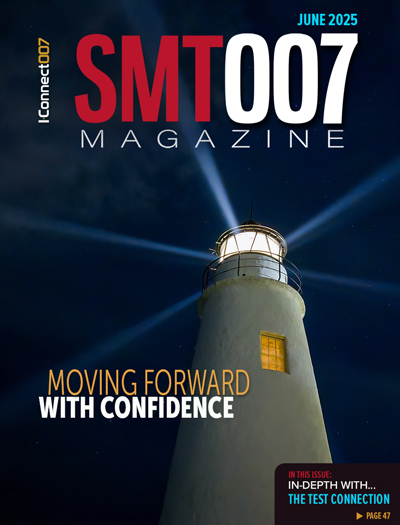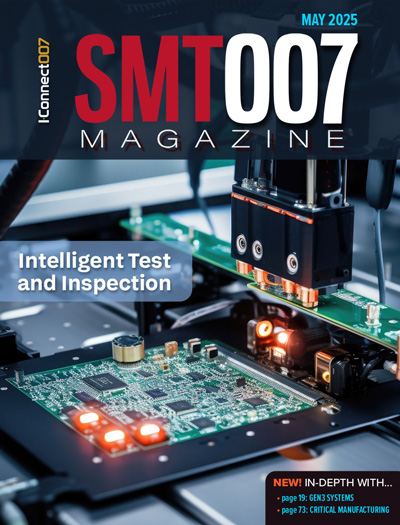-

- News
- Books
Featured Books
- smt007 Magazine
Latest Issues
Current Issue
What's Your Sweet Spot?
Are you in a niche that’s growing or shrinking? Is it time to reassess and refocus? We spotlight companies thriving by redefining or reinforcing their niche. What are their insights?

Moving Forward With Confidence
In this issue, we focus on sales and quoting, workforce training, new IPC leadership in the U.S. and Canada, the effects of tariffs, CFX standards, and much more—all designed to provide perspective as you move through the cloud bank of today's shifting economic market.

Intelligent Test and Inspection
Are you ready to explore the cutting-edge advancements shaping the electronics manufacturing industry? The May 2025 issue of SMT007 Magazine is packed with insights, innovations, and expert perspectives that you won’t want to miss.
- Articles
- Columns
- Links
- Media kit
||| MENU - smt007 Magazine
Learning to Speak ‘Fab’
April 23, 2025 | Ray Fugitt, DownStream TechnologiesEstimated reading time: 1 minute
Over the years, I’ve seen many PCB designers make DFM mistakes. At DownStream, I work with design and fabrication, and sometimes it feels as if the two segments are speaking completely different languages. But once designers learn to speak “fab,” many of these DFM challenges disappear.
I taught a class at PCB East 2024, “The 21 Most Common Design Errors Caught by Fabrication (and How to Prevent Them),” with my co-presenter Mike Tucker of Millennium Circuits. At PCB West 2024, we presented an updated class, “10 (More) Common Errors in PCB Design and How to Catch Them.” Is this an evergreen topic?
Design007 Editor Andy Shaughnessy and columnist Kelly Dack attended our PCB West class, which was packed with designers and design engineers, and many of them had questions. When Andy asked me to contribute an article on the most common miscommunication errors made by PCB designers, I said, “Sign me up.”
You Know the Drill
Let’s start with the drill chart shown in Figure 1. It seems like a normal drill chart at first. But take another look. What is a “finished drill size” anyway? Do they mean hole size? What’s the difference?
To read this entire article, which appeared in the March 2025 issue of Design007 Magazine, click here.
Testimonial
"Advertising in PCB007 Magazine has been a great way to showcase our bare board testers to the right audience. The I-Connect007 team makes the process smooth and professional. We’re proud to be featured in such a trusted publication."
Klaus Koziol - atgSuggested Items
Zuken to Showcase Defence & Security-Focused Electronic Systems Design Solutions at DSEI 2025
07/24/2025 | ZukenZuken, a global leader in electronic and electrical design automation, will showcase its latest innovations for defence and security systems at DSEI 2025, taking place at ExCeL London from 9–12 September 2025.
Creating a Design Constraint Strategy
07/24/2025 | I-Connect007 Editorial TeamMost designers learn how to set their design constraints through trial and error. EDA vendors’ guidelines explain how to use their particular tools’ constraints, and IPC standards offer a roadmap, but PCB designers usually develop their own unique styles for setting constraints. Is there a set of best practices for setting constraints? That’s what I asked Global Electronics Association design instructor Kris Moyer, who covers design constraints in his classes.
Elementary Mr. Watson: Closing the Gap Between Design and Manufacturing
07/23/2025 | John Watson -- Column: Elementary, Mr. WatsonModern PCB designers are not merely engineers or technicians. I believe that PCB design, at its core, is an art form, and modern PCB designers should be considered artists. Beyond the technical calculations and engineering rules lies a creative process that involves vision, balance, and a passion for what we do. Like any artist who works with brush and canvas or chisel and stone, a PCB designer shapes invisible pathways that bring ideas to life. Each trace, layer, and component placement reflects thoughtful decisions that blend form, fit, and function.
Designers Notebook: Basic PCB Planning Criteria—Establishing Design Constraints
07/22/2025 | Vern Solberg -- Column: Designer's NotebookPrinted circuit board development flows more smoothly when all critical issues are predefined and understood from the start. As a basic planning strategy, the designer must first consider the product performance criteria, then determine the specific industry standards or specifications that the product must meet. Planning also includes a review of all significant issues that may affect the product’s manufacture, performance, reliability, overall quality, and safety.
Microchip Enters into Partnership Agreement with Delta Electronics on Silicon Carbide Solutions
07/18/2025 | Globe NewswireThe growth of artificial intelligence (AI) and the electrification of everything are driving an ever-increasing demand for higher levels of power efficiency and reliability.


